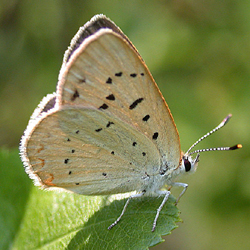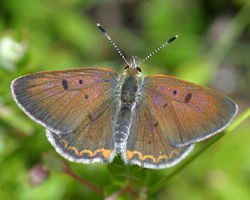Butterfly Atlas
Find a Butterfly
Bog Copper
Lycaena epixanthe
Named
Boisduval and Leconte, 1833

Identification
Wingspan: 3/4 -1". Of the three coppers occurring in Massachusetts this is the smallest and has the most restricted habitat. Because of its close association with cranberry (mainly Vaccinium macrocarpon) and the bogs and wet meadows in which it grows, habitat is an excellent clue to identification. Both males and females lack the large orange areas present in our other two coppers.
Distribution
Central Ontario and Minnesota east to Newfoundland and south through Great Lakes Region, West Virginia and New Jersey. Throughout New England excepting northern most New Hampshire and central and northern Maine.
Status in Massachusetts
Bog Copper colonies are scattered throughout the state and where found the butterfly may be locally common or overabundant. Maxima: 2,000+, 11 July 1992, Reading (Middlesex Co.).

Flight Period in Massachusetts
Late June through late July. Extreme dates: 16 June, Nantucket (Nantucket Co.); 5 August 1995, Sterling (Worcester Co.), T. Dodd.
Larval Food Plants
Large and small Cranberries (Vaccinium macrocarpon and V. oxycoccos).
Adult Food sources
Seldom seen nectaring, but observed at Black-eyed Susan.

Habitat
The traditional association of Bog Copper, frequently quoted in the literature and partially indicated by its common name, is bogs containing cranberry. While Atlas workers found this butterfly in such habitats, several sizable colonies were found in acidic wet meadows, at times associated with alluvial soils of river flood plains. Thus, while cranberry is critical, Bog Copper should be also looked for in other types of acidic wetlands.
Life Cycle
EGG: White; turban shaped and heavily pitted. OVIPOSITION: Eggs laid singly on woody stem and underside of leaves of cranberries. LARVA: Bluish green with a dark green back stripe, light green lateral lines, and dark, oblique dashes on the sides; feeds on cranberry leaves and shoots. CHRYSALIS: Yellow to green with dark blotches and white spotting; rarely deep purple. OVERWINTERING STAGE: Egg.
Notes
Absent in commercial bogs where pesticide use is heavy.
Account Author
Richard K. Walton



